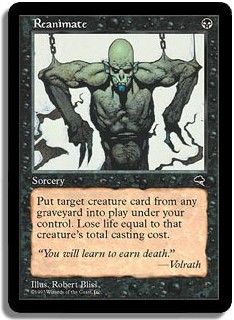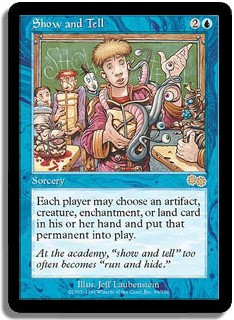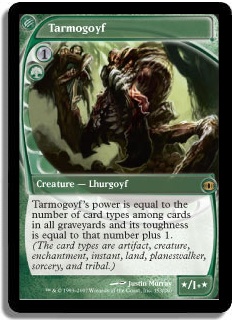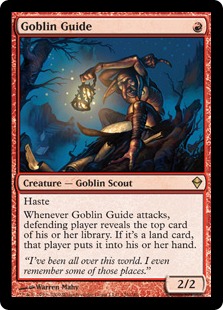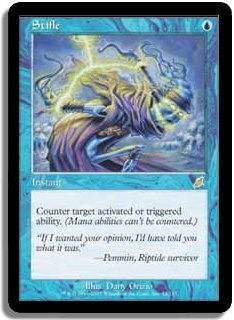With Grand Prix Atlanta and the SCG Legacy Open in Seattle upon us in just a few, short days, Legacy is catching the spotlight. People are grasping for decklists, new technology, and any information on their favorite decks as they prepare for the event! Legacy has become one of my favorite formats, and for good reason. The depth of card quality allows for absurd range in deckbuilding, and I generally find that nearly any deck can do well when honed into a well-oiled machine, as long as what you’re doing is inherently powerful.
With that said, certain cards that are cropping up en mass in today’s Legacy metagame are pushing fringe decks into a bit of a corner. Unfortunately, there isn’t much to do other than hate them out or play them yourself. Currently, this guy is my main offender:
Griselbrand makes me very uncomfortable when I play against him, because he just screams out for attention when he hits the table. If you can’t deal with him immediately, you need to have a way to deal with him over and over that can’t be Force of Willed (i.e., Karakas). If you are relying on Swords to Plowshares or some other means of defense, then you are fighting a losing battle. A lot of people are also running multiple copies of Misdirection in order to keep you off balance, since they are nearly Force of Will against spot removal (sometimes) and counterspells.
The best way to "deal" with Griselbrand is to keep him off the table entirely. This can be done a variety of ways, but you can bet that most people aren’t casting him from their hand. Generally speaking, people are going to try to "cheat" Griselbrand into play in one form or another. I think it is safe to say that the easiest (and most played) ways to cheat Griselbrand into play are as follows:
Sure, there are other ways, like the countless number of Reanimation spells available, Hypergenesis, Sneak Attack, and a few (more interesting) others. While there are a lot of ways to actually get him into play for less than eight mana, most of these methods have something very interesting in common. The fact is that all of these cards are spells, in the sense that they are not creatures. This means that your number one weapon when fighting these strategies in your fair deck should be, as you probably have guessed…
Now, what am I trying to say here? Spell Pierce is not an auto-include to any blue deck. In fact, I don’t even really like Spell Pierce all that much outside of the "fair" decks (aka non-combo). I think that Spell Pierce in Legacy acts much like Mana Leak in Standard. The best decks and strategies that play Spell Pierce are those that force the opponent to rush their spells on to the table. If they can wait and wait until the perfect time to play out their big turn, then Spell Pierce becomes worse over time. Spell Pierce suffers a similar fate to Daze in that your opponent will be able to play around it eventually. The trick is forcing them to play into you by applying enough pressure.
Without pressure in some form, combo players have no obligation to try and "go off." They will just build up their resources and, ultimately, the perfect hand. Most combo decks have enough ways to disrupt you without the need to be given extra time. So what are we going to do? How do we apply enough pressure to make our cheap counterspells good?
The thing that these threats have in common is that they are cheap and pair reasonably well with blue disruption thanks to the amount of pressure they can apply in such a short amount of time. While Stoneforge Mystic doesn’t directly apply the pressure, the threat of Batterskull or Umezawa’s Jitte should be enough to get their blood pumping and ultimately allow your countermeasures to do their job. Without the appropriate pressure, all the situational counterspells in the world aren’t going to save you (unless your opponent decides that they want to lose the game for absolutely no reason).
For whatever it’s worth, I feel like Spell Pierce is most effective in RUG Delver for a few different reasons. While RUG Delver has a pretty swift clock, it tends to combine this pressure with mana denial in the form of Wasteland and Stifle. While not every version of RUG Delver plays Stifle, it is generally correct to play around Stifle when possible, as the effects can be devastating when unexpected. If I were playing RUG Delver at the Grand Prix this weekend, I would be playing some number of Stifles, both for blowout potential and because few people will see it coming.
While Spell Pierce is very good right now, Daze is equally important and probably a bit better. The "free" part of Daze allows for some absurdly aggressive plays and will also occasionally allow you to get away with murder. People are so afraid of Spell Pierce that they will often have no choice but to go for whatever spell they are trying to resolve, even at the expense of losing to Daze. There is rarely a good time to play around Daze, as most decks that play Daze do so for a very good reason. Thanks to the mana disruption from RUG or the outrageously fast pace from Reanimator, Daze is a card that you are rarely able to play around. When you can play around Daze, I would recommend you do so. But, if you don’t have that luxury, don’t sit back and get pounded into the dirt. Recognizing the situation against either of these decks and figuring out your best line of play based on what they could have is very important.
So what are we doing here? Are we really trying to fend off Griselbrand? With such a wide array of decks and *gasp* forty-something Lands winning the last SCG Legacy Open, as well as a ton of good players piloting Elves, why are we hating on Griselbrand? We would not want to be guilty of a hate crime or show any amount of disrespect towards a creature because of the color of his mana symbol. That would be insensitive.
After all, I’ve discovered that a lot of decks in Legacy are able to actually compete when their opponent draws fourteen-plus cards in a single turn. Maybe that says something about the overall health or power level of the format, but people are more prepared than I gave them credit for. Perhaps that was just at the SCG Invitational, but I expect Day 2 of Grand Prix Atlanta to be similar. Competent players will have Gilded Drake. They will have Karakas. If you are playing Griselbrand, you will lose games because of this and drawing fourteen cards will not help you (all of the time).
Let us pretend for a moment that you don’t like casting blue spells (hilarious, right?). What is a green mage to do in order to fend off the big baddies in such a hostile format? For one, it mostly depends on what color(s) you’re pairing with your Forests, but I’m a huge advocate of Maverick right now since you have a ton of options to build for changes in the metagame. Since more players are leaning towards Show and Tell and graveyard based combo decks, Maverick finds a natural fit in the current metagame. You are also mostly favored against the "fair" decks because your overall card quality and disruption is potent against them.
Wasteland is a helluva drug.
If we’re pairing green with white, we’re just playing the same ol’ Maverick, but not everything has to stay the same. After all, Green Sun’s Zenith and Knight of the Reliquary allow you to play a variety of one-of Tutor targets, giving you the best possible threat or disruptive creature in any given situation. While Gaddock Teeg isn’t positioned that well in the current metagame, he still keeps a lot of opponents from doing all that much while you beat them down.
For reference, here is my current list for Maverick in Legacy:
4 Noble Hierarch
4 Thalia, Guardian of Thraben
4 Knight of the Reliquary
4 Green Sun’s Zenith
4 Swords to Plowshares
4 Windswept Heath
4 Savannah
4 Wasteland
That’s it. Everything else fluctuates. Every tournament I attend, I sit down and try to come up with the best plan and suite of Tutors that will help me win the tournament. Some days, that ends up being Elesh Norn, Loyal Retainer, and Fauna Shaman. In others, it ends up being fewer tricks and more on the straightforward side with extra copies of the best spells in my deck. For instance, I think that Qasali Pridemage should be played a bit less at the moment while Scavenging Ooze should be played a bit more, but that is just one piece of the puzzle.
I don’t even think Mother of Runes belongs in the deck in about a fourth of the tournaments I play in with the deck!
As I’ve said in previous articles concerning Maverick, Mother of Runes is only good when you don’t want to attack with her. The more times throughout the tournament where she attacks, the worse she is at her job. When she’s bad at her job, she’s just a Bushi Tenderfoot that never flips, and that isn’t a card that I want in my deck. While Mother of Runes has been maxed out as a four-of in every Maverick list I’ve ever seen, I might just board her at my next event. And that brings me to my next point…
One thing I’ve noticed with players who play a lot of Legacy is that they tend to change very little about their deck from tournament to tournament. I think that Maverick players can be incredibly guilty of this, because I am constantly being questioned and criticized about each and every card change I make in the deck. Spike Feeder was a huge wake-up call, showing me just how much people don’t like change as the amount of trolling on Twitter was a bit much. Kitchen Finks is worse in the matchups where you need the effect, but it is generally accepted as a better creature, thus making it the "go-to" Green Sun’s Zenith target. Add to this the fact that Spike Feeder is actually pretty sweet against Dredge and actively better than Kitchen Finks against mono-red decks and the comparison isn’t really that close.Â
People don’t like change, and most of them specifically dislike it when you change something that they hold very dear. My biggest advice about Legacy is that you should never hold anything as pure truth. Cards can be cut from decks. New archetypes can be given life with the printing of a single card. Old archetypes can be revived with the banning or unbanning of a card or cards. Nothing is ever exactly what it seems, and you should never discount any deck just because it "looks bad." There’s a lot to learn from anyone and everyone who plays Legacy at a high level, because those people are probably pretty smart. This is one of the reasons why I respect the Hatfield brothers so much, as they exemplify everything I love about the format. They continually progress archetypes, find new ways to dominate postboard matchups, and exploit formats as a whole. They are architects using Magic’s history as building blocks, constantly finding new ways to attack the format.
Don’t be afraid to shake things up! StarCityGames.com Legacy Opens should be used as testing grounds for new archetypes. Grand Prix tournaments should show off and reward innovation. I mean, the last Legacy Grand Prix was won using Lingering Souls, a card that was barely on anyone’s radar for Legacy even though it was dominating Standard at the time. Figure out what you enjoy playing, and make it good! At the very least, you can be proud of trying something new and different.
For this weekend, if you are attending GP Atlanta or the SCG Legacy Open in Seattle, I wish you well. Legacy is an amazing format that allows for an extensive amount of interaction and play if you put yourself in a position to do so. If you are playing an aggressive deck with zero disruption, don’t expect any of your opponents to be fighting fair. If you are playing a control deck, make sure that you are using the most powerful and efficient preventative measures at your disposal. If you are playing a combo deck, try your best to dodge as much hate as possible, because being slightly off the radar can greatly benefit you when facing off against a multitude of postboard hate cards.
While I don’t have any decklists set in stone, I will say that my favorite three archetypes right now are Reanimator, RUG Delver, and Maverick. I think that these three decks are very well positioned right now or are just inherently powerful. They are the best at what they do.
- Reanimator cheats creatures into play faster and more consistently than any other deck and can run the best disruption since it is both blue and black already. While it is more susceptible to hate thanks to its use of the graveyard, I still think it is worth playing.
- RUG Delver is the best aggressive deck for fighting off random opponents. While a lot of your deck is "metagamed" to help beat certain decks, you get a ton of free wins thanks to cards like Delver of Secrets and Wasteland. I highly recommend this deck for people who are good at playing Delver in Standard, though the decision trees can be infinitely more complex.
- Maverick is a great disruptive deck that matches up well against the fair decks. Your combo matchups can be a bit rough if they are "all-in" on something like Goblin Charbelcher or the like, but Thalia and Wasteland are pretty solid in a lot of matchups. You also have access to a lot of amazing sideboard cards that a lot of decks can’t really handle. Karakas alongside Knight of the Reliquary is also a huge thumbs up.
I will be choosing between these three decks this weekend, but I’m still not sure which one is best positioned. After some more discussion with the guys in Roanoke, as well as playing some more matches myself, I feel confident that I will come up with the best decision for me regardless of what the rest of my teammates decide to play. After all, that is one of the most amazing things about Legacy. Just playing with a certain deck over a long period of time will give you a natural advantage over an opponent who has just picked their deck up for the first time. An intricate knowledge of your cards, interactions, and matchups is incredibly important with such an open field.
Play what you know. Play what you love.
Thanks for reading.
strong sad on Magic Online
@strong_sad on Twitter, Follow ME!


